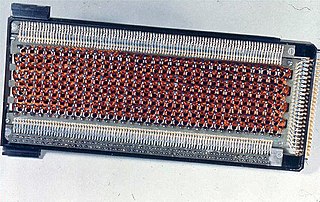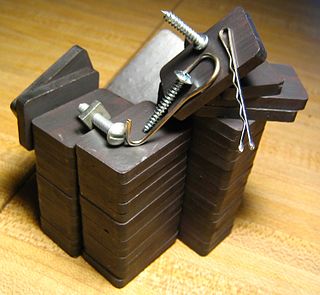
In computing, magnetic-core memory is a form of random-access memory. It predominated for roughly 20 years between 1955 and 1975, and is often just called core memory, or, informally, core.

The IBM 650 Magnetic Drum Data-Processing Machine is an early digital computer produced by IBM in the mid-1950s. It was the first mass-produced computer in the world. Almost 2,000 systems were produced, the last in 1962, and it was the first computer to make a meaningful profit. The first one was installed in late 1954 and it was the most popular computer of the 1950s.

UNIVAC was a line of electronic digital stored-program computers starting with the products of the Eckert–Mauchly Computer Corporation. Later the name was applied to a division of the Remington Rand company and successor organizations.

Drum memory was a magnetic data storage device invented by Gustav Tauschek in 1932 in Austria. Drums were widely used in the 1950s and into the 1960s as computer memory.

The IBM 7090 is a second-generation transistorized version of the earlier IBM 709 vacuum tube mainframe computer that was designed for "large-scale scientific and technological applications". The 7090 is the fourth member of the IBM 700/7000 series scientific computers. The first 7090 installation was in December 1959. In 1960, a typical system sold for $2.9 million or could be rented for $63,500 a month.

Bubble memory is a type of non-volatile computer memory that uses a thin film of a magnetic material to hold small magnetized areas, known as bubbles or domains, each storing one bit of data. The material is arranged to form a series of parallel tracks that the bubbles can move along under the action of an external magnetic field. The bubbles are read by moving them to the edge of the material, where they can be read by a conventional magnetic pickup, and then rewritten on the far edge to keep the memory cycling through the material. In operation, bubble memories are similar to delay-line memory systems.
Thin-film memory is a high-speed alternative to magnetic-core memory developed by Sperry Rand in a government-funded research project.

The UNIVAC 1100/2200 series is a series of compatible 36-bit computer systems, beginning with the UNIVAC 1107 in 1962, initially made by Sperry Rand. The series continues to be supported today by Unisys Corporation as the ClearPath Dorado Series. The solid-state 1107 model number was in the same sequence as the earlier vacuum-tube computers, but the early computers were not compatible with their solid-state successors.

Pioneer 6, 7, 8, and 9 were space probes in the Pioneer program, launched between 1965 and 1969. They were a series of solar-orbiting, spin-stabilized, solar cell- and battery-powered satellites designed to obtain measurements on a continuing basis of interplanetary phenomena from widely separated points in space. They were also known as Pioneer A, B, C, and D. The fifth was lost in a launch accident, and therefore did not receive a numerical designation.

Core rope memory is a form of read-only memory (ROM) for computers. It was used in the UNIVAC I and the UNIVAC II, developed by the Eckert-Mauchly Computer Corporation in the 1950s, as it was a popular technology for program and data storage in that era. It was later used in the 1960s by early NASA Mars space probes and then in the Apollo Guidance Computer (AGC), which was built by Raytheon.

Magnetic storage or magnetic recording is the storage of data on a magnetized medium. Magnetic storage uses different patterns of magnetisation in a magnetizable material to store data and is a form of non-volatile memory. The information is accessed using one or more read/write heads.
Reading is an action performed by computers, to acquire data from a source and place it into their volatile memory for processing. Computers may read information from a variety of sources, such as magnetic storage, the Internet, or audio and video input ports. Reading is one of the core functions of a Turing machine.

The UNISERVO tape drive was the primary I/O device on the UNIVAC I computer. It was the first tape drive for a commercially sold computer.
Density is a measure of the quantity of information bits that can be stored on a given physical space of a computer storage medium. There are three types of density: length of track, area of the surface, or in a given volume.

A ferrite is one of a family of iron oxide-containing magnetic ceramic materials. They are ferrimagnetic, meaning they are attracted by magnetic fields and can be magnetized to become permanent magnets. Unlike many ferromagnetic materials, most ferrites are not electrically conductive, making them useful in applications like magnetic cores for transformers to suppress eddy currents.
Racetrack memory or domain-wall memory (DWM) is an experimental non-volatile memory device under development at IBM's Almaden Research Center by a team led by physicist Stuart Parkin. It is a current topic of active research at the Max Planck Institute of Microstructure Physics in Dr. Parkin's group. In early 2008, a 3-bit version was successfully demonstrated. If it were to be developed successfully, racetrack memory would offer storage density higher than comparable solid-state memory devices like flash memory.

Read-only memory (ROM) is a type of non-volatile memory used in computers and other electronic devices. Data stored in ROM cannot be electronically modified after the manufacture of the memory device. Read-only memory is useful for storing software that is rarely changed during the life of the system, also known as firmware. Software applications, such as video games, for programmable devices can be distributed as plug-in cartridges containing ROM.
(Dr.) Dudley Allen Buck (1927–1959) was an electrical engineer and inventor of components for high-speed computing devices in the 1950s. He is best known for invention of the cryotron, a superconductive computer component that is operated in liquid helium at a temperature near absolute zero. Other inventions were ferroelectric memory, content-addressable memory, non-destructive sensing of magnetic fields, and writing printed circuits with a beam of electrons.

The UNIVAC 9000 series is a discontinued line of computers introduced by Sperry Rand in the mid-1960s to compete with the low end of the IBM System/360 series. The 9200 and 9300 implement the same restricted 16-bit subset of the System/360 instruction set as the IBM 360/20, while the UNIVAC 9400 implements a subset of the full 32-bit System/360 instruction set. The 9400 was roughly equivalent to the IBM 360/30.

A vacuum-tube computer, now termed a first-generation computer, is a computer that uses vacuum tubes for logic circuitry. While the history of mechanical aids to computation goes back centuries, if not millennia, the history of vacuum tube computers is confined to the middle of the 20th century. Lee De Forest invented the triode in 1906. The first example of using vacuum tubes for computation, the Atanasoff–Berry computer, was demonstrated in 1939. Vacuum-tube computers were initially one-of-a-kind designs, but commercial models were introduced in the 1950s and sold in volumes ranging from single digits to thousands of units. By the early 1960s vacuum tube computers were obsolete, superseded by second-generation transistorized computers.














